
Professor of Civil Engineering at the Royal Military College of Canada
Dr. Bathurst (BSc., MSc., Ph.D. 1986 Queen's) is Professor of Civil Engineering at the Royal Military College of Canada where he has taught since 1980. He also holds a cross-appointment with the Civil Engineering Department at Queen's University. He has been an Adjunct Professor of Civil Engineering at the University of Waterloo and Ryerson University (Canada) and Edith Cowan University in Australia. He was visiting Distinguished Scientist at King Abdulaziz University, Jeddah, Saudi Arabia in 2013-14. He holds an appointment as Visiting Research Fellow at the Port and Airport Research Institute in Japan (2016-2021).
He is Past-President of the North American Geosynthetics Society, Past-President of the International Geosynthetics Society, Past-President of the Canadian Geotechnical Society and recently completed a two-year term as President of the Engineering Institute of Canada.
Dr. Bathurst has authored or co-authored more than 450 papers in referred journals, conference proceedings and research monographs.
Current research activities are focused on the use of geosynthetic and metallic reinforcement in earth retaining wall systems, seismic performance and design, limit states design, probabilistic design of reinforced and unreinforced soil structures, and load and resistance factor design (LRFD) calibration. Dr Bathurst currently serves on committees of the Canadian Highway Bridge Design Code and the National Building Code of Canada.
Dr. Bathurst is editor of the peer-reviewed technical journal Geosynthetics International which is an official journal of the International Geosynthetics Society and published by ICE/Thomas Telford, and co-editor of the ASCE International Journal of Geomechanics
Lecture Title: Developments in MSE Wall Research and Design
Mechanically stabilized earth (MSE) walls constructed with steel and geosynthetic reinforcing elements are now well-established technologies. The lecture gives a brief historical overview and then a review of current approaches to the design of these systems including strength-based limit equilibrium methods and reinforcement stiffness-based methods. Examples of full-scale wall testing in North America and Japan are described which have proved valuable to quantify the accuracy of current methods to calculate reinforcement loads under operational conditions. The lecture explains how these measured data have been used to develop simple load and resistance models for pullout and rupture limit states that are more accurate and amenable to reliability-based design. These models are candidates for future editions of the AASHTO code in the USA and the Canadian Highway Bridge Design Code. Finally, the movement towards reliability-based internal stability analysis and design of MSE walls, and the link to load and resistance factor design (LRFD) calibration is explained.
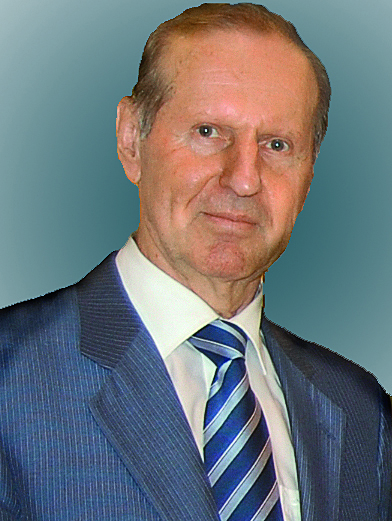 Prof. Emeritus, Vienna University of Technology, Austria
Prof. Emeritus, Vienna University of Technology, Austria
Prof. H. Brandl has been Full Professor for Soil and Rock Mechanics and Foundation Engineering (including Tunnelling) since 1977, chairing until 2009 the prestigious Institute for Soil Mechanics and Geotechnical Engineering, which was founded by Prof. Karl Terzaghi in 1928 at the Vienna University of Technology. Since 2008 he is Prof. Emeritus.
Professor Brandl authored about 580 scientific publications (including 21 books), partly published in 18 languages. The subjects cover laboratory and field testing, soil and rock mechanics, foundation engineering, slope engineering, earthworks, tunnelling, urban undergrounds, restoration of historical buildings, road and railway engineering, hydro/hydraulic engineering and environmental engineering, geosynthetics, geothermal engineering (“energy foundations”, “energy tunnels” etc.), natural disaster mitigation and rehabilitation, etc. He also published on philosophical aspects and on ethics in the profession. From the very outset of his professional work H. Brandl has been bridging the gap between theory and practice. He has been fully responsible for nearly 4000 projects of civil engineering, geotechnical and environmental engineering in Austria and elsewhere.
Prof. Brandl has been active world-wide since 1968 as chairman, general reporter, state-of-the-art reporter, special-, keynote- and opening lecturer, discussion leader and panellist at numerous international conferences on geotechnical engineering, environmental engineering, geosynthetics, etc. He was Rankine Lecturer (2001), Giroud Lecturer (2010), and he created the prestigious “Vienna Terzaghi Lecture”. He was Vice-President ISSMGE (1997 - 2001), and from 1973 to 2015 President of the Austrian Geotechnical Society. Moreover, he is a member of the Royal Academy of Sciences of Belgium, of the International Academy of Engineers (Moscow) and other Scientific Academies. Since June 2003 he has been President of the Austrian Society for Engineers and Architects (founded in 1848). He received numerous national and international awards (e.g. Kevin Nash Gold Medal), honorary doctorates and other honours.
Long-term settlement (creeping) of soft soils, and ground improvement
The keynote lecture focuses on the long-term settlement (creeping) of highly compressible soils, considering also soft sludge. Long-term oedometer tests lasted up to 42 years and were performed on silty sand, (organic) clayey silt, peat and (pre- treated) sewage sludge. Secondary consolidation (creep) could be observed in all cases, lasting over many years and occurring widely linear with the logarithm of time. However, temporary acceleration may also be observed, indicating a discontinuous nature of internal deformations due to accelerated rearrangement in the fabric – mainly in very soft soils with peaty components. This long-term phase is followed by tertiary creeping with a long lasting fading out period. In both phases micro-cristaline sliding occurs. In addition to the laboratory tests results of comprehensive field measurements are summarized, showing the influence of different ground improvement methods on the creeping behaviour of highly compressible fine-grained soils (partly organic). Most data were collected from a highway junction with embankments on highly compressible, heterogeneous ground (locally 15 m deep and with a natural water content up to 1000%), constructed between 1972 and 1974, and monitored since. Different ground improvement methods were compared, disclosing details of primary, secondary and tertiary settlement: Deep dynamic compaction/consolidation (heavy tamping), vibroflotation (piled embankments), temporary surcharge loading, and local combinations of the previous methods.
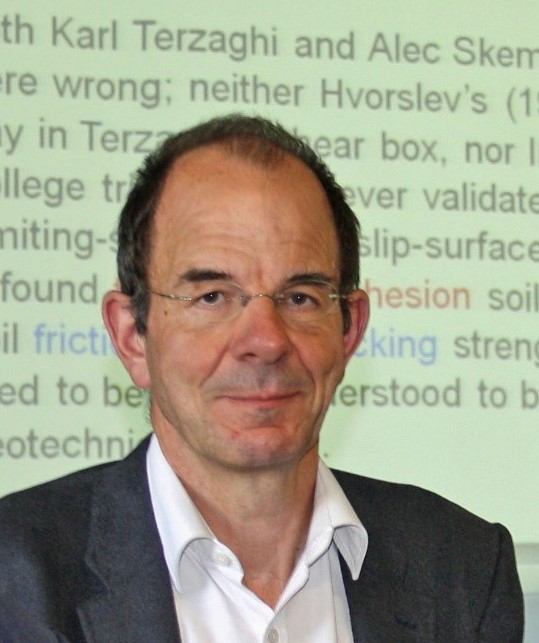
Chairman TC 204 ISSMGE
Ghent University / Deltares
Adam Bezuijen is professor in soil mechanics and geotechnics at Ghent University in Belgium and part-time senior specialist at Deltares, Delft, the Netherlands.
He worked fulltime at Deltares before becoming a professor. At Deltares he was involved in research on revetments, dredging, tunnelling, geotextiles and model testing and was the scientific coordinator of the geotechnical centrifuge of Deltares. As a professor in Ghent, he guides PhD and Post-doc research on tunnelling, piled embankments, geotextile reinforcement, polymer treated bentonite and backward erosion piping.
He is chair of the ISSMGE technical committee TC204 “Underground construction in Soft ground” and member of TC104 “Physical Model Testing”.
Lecture Title: Slurry and foam to stabilize the front face during TBM tunnelling
Mechanisms in saturated sand
Slurry and foam are used to stabilize the front face during during TBM tunnelling. Slurry when a slurry shield TBM is used and foam for an EPB. For both types of TBM the slurry and the foam are used to create a low permeable front face. Quite some research has been performed how much and what foam has to be added for soil conditioning and how slurry causes a filter cake at the front face. However, in most of this research, the interaction between flow from the TBM, induced because the face pressure must be higher than the water pressure in non-cohesive soil, and the groundwater flow has not sufficiently been taken into account.
The lecture will describe this interaction. Furthermore, the influence of the soil concentration in the mixing chamber on the permeability of the front face will be discussed, as well as the influence on the stability of the tunnel front. The methods developed have been verified with various tunnel projects in The Netherlands, USA and Italy.
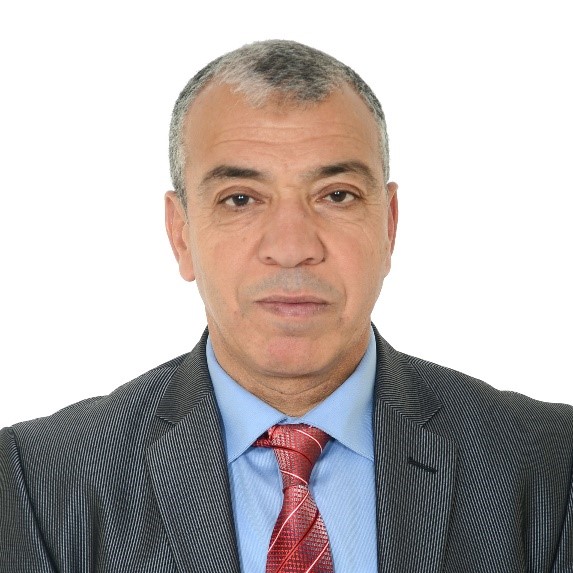
Appointed Board Member, ISSMGE
Bouassida is a professor of civil engineering at the National Engineering School of Tunis (ENIT) of the University of Tunis El Manar where he earned his B.S., M.S., Ph.D., and doctorate of sciences diplomas, all in civil engineering. He is the director of the Research Laboratory in Geotechnical Engineering and Georisk. Dr M. Bouassida has supervised 20 Ph.D. and 30 master of science graduates. His research focuses on soil improvement techniques and behavior of soft clays. Dr. Bouassida is the (co)author of about 91 papers in refereed international journals; 130 papers, including 21 keynote lectures; and three books. He is also co-editor of ten published proceedings of international conferences.
He is a member of the editorial committees of journals Ground Improvement (ICE), Geotechnical Geological Engineering, Infrastructure Innovative Solutions, and International Journal of Geomechanics (ASCE). He is also an active reviewer in several international journals. As a 2006 Fulbright scholar, Dr. Bouassida elaborated a novel methodology for the design of foundations on reinforced soil by columns. He was awarded the 2006 S. Prakash Prize for Excellence in the practice of geotechnical engineering. In 2008, Bouassida launched a Tunisian consulting office in geotechnical engineering, SIMPRO. He is a co-developer of the software Columns 1.01 used for designing column-reinforced foundations. Prof. Bouassida held the office of the vice president of ISSMGE for Africa (2005–2009). He benefited from several grants as a visiting professor in the USA, France, Belgium, Australia, Vietnam, Hong Kong and Norway. Recently, Prof. Bouassida became an appointed member of the ISSMGE board (2017-2021). He is managing the webinars activity within the newly established program of ISSMGE virtual university.
Ground Improvement - Tunisian case histories
Ground improvement techniques are often practiced for a wide range of infrastructure projects, especially in coastal areas where the soil profile usually includes weak and compressible saturated soils. In such condition, three Tunisian case histories are presented and analyzed. The first case history addresses the retrofit of an oil tank at La Goulette North suburb of Tunis City. After unsuccessful improvement by sand compaction piles, the reinforcement by micropiles permitted the stopping of non-admissible consolidation settlement, and, then, the restart of tank operation. The second case history, lived in the South-Eastern of Tunisia (Ghannouche county, Gabès City), details a successful reinforcement by floating stone columns for GPL storage facility in mounded banks. The follow up of settlement during the construction of storage facility served as an assessment tool of settlement predictions obtained by Plaxis code. The third case study focuses on the improvement of Tunis soft clay by geodrains to accelerate the settlement of access ramps of the Interchange “Cyrus Le Grand”, located in Tunis center. Recorded consolidation settlements which resulted from stage construction embankment preload, were found in good agreement with numerical predictions obtained by Plaxis code after adopting the Soft Soil Model and the Hardening Soil Model for Tunis Soft clay. From the investigated cases histories, it is emphasized that the success of any ground improvement technique relies on very good soil investigation, suitable design of adopted ground improvement technique and, importantly, the follow up of in-situ behavior of improved soil.
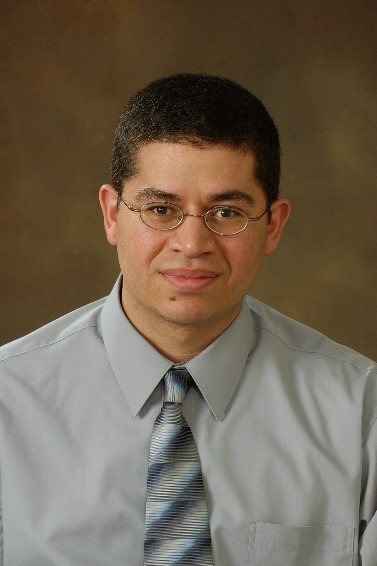
Professor, University of Texas at San Antonio, USA
Dr. Samer Dessouky is a professor of Civil and Environmental Engineering at University of Texas at San Antonio. He has more than 18 years of research experience in highway construction materials, sustainability and traffic safety. His research is sponsored by the City of San Antonio, Texas DOT, U.S. DOT, Federal Highway Administration, CPS energy and others. He is the author of more than 100 refereed publications on pavement management, energy harvesting and motorists safety. Along with his students he received several national awards such as the best green engineering technology award by ASCE in 2016 and 2017 and Transportation Achievement Award by ITE in 2018. He also serves as the associate director of the regional university transportation center (Tran-SET) and chair of Bituminous Committee of the construction institute. He is a professional engineer in Ohio and Texas.
Lecture Topic: Sustainable and Safer Roadways through Innovative Energy Harvesting Solutions
This work aims to develop innovative solutions to re-utilize roadway pavements as sources of generating electrical power for useful applications such as lighting, sensing, detection and structural health monitoring particularly at remote areas. The presentation will introduce several approaches on energy harvesting using piezoelectric transducers, thermoelectric generators, and electromagnetic systems and their applications in roadways. This is an emerging research field which encompasses technologies that capture the existing wasted energy in pavement to generate low-watt electricity without depleting natural resources. Thermal energy from temperature gradient in pavement layers and strain energy induced from traffic loading are examples of wasted energy sources. Three prototypes currently developed at University of Texas at San Antonio will be presented including their laboratory and field experimentation. The produced power can range from 27 mWatt upto 6.5 Watt based on laboratory analysis. A comparison between the three prototypes will be introduced for long term implementation and deployment in roadway network.
.
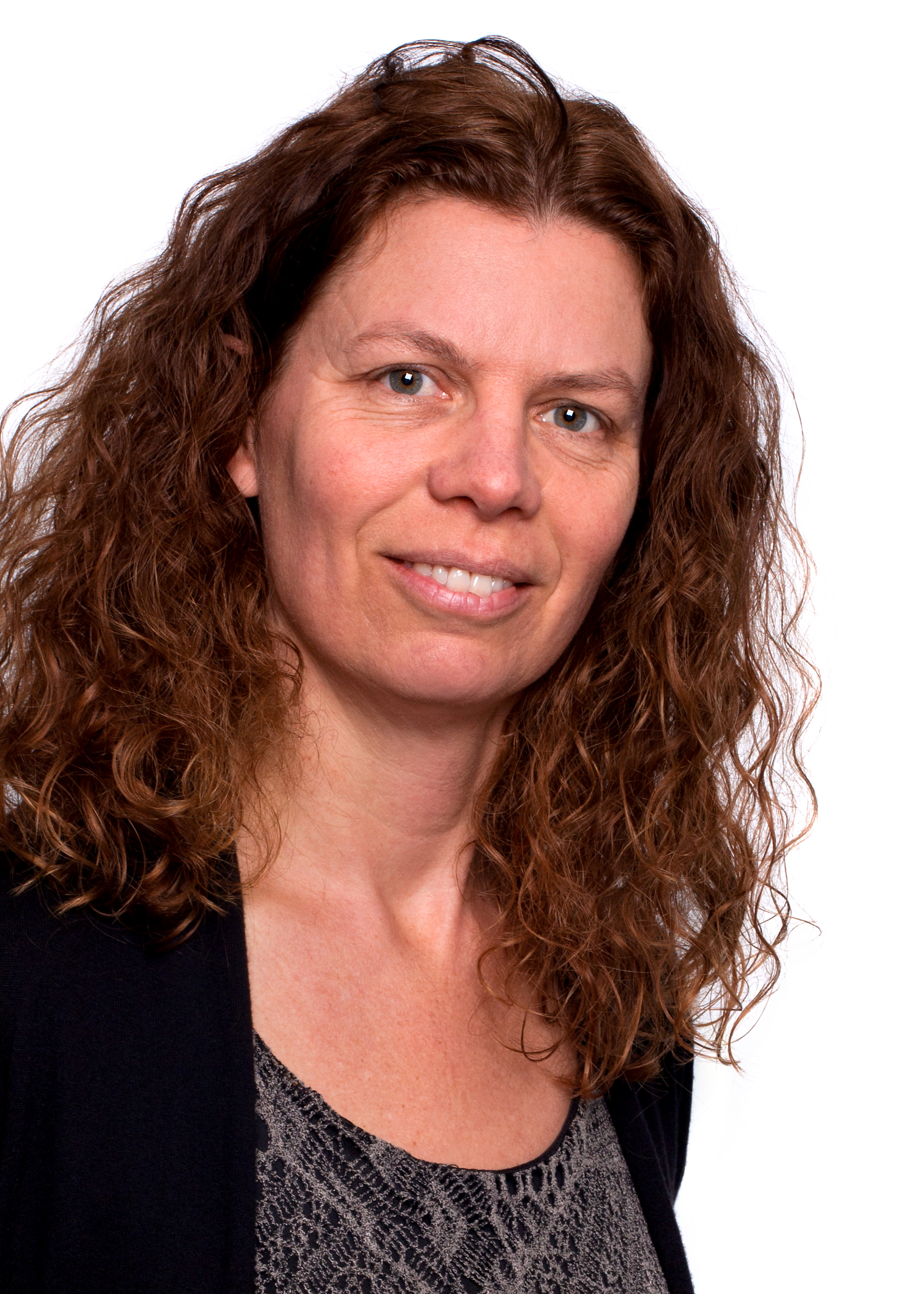 Expert in geotechnical engineering and geosynthetic reinforcement and piled embankments at Deltares
Expert in geotechnical engineering and geosynthetic reinforcement and piled embankments at Deltares
Dr. Suzanne van Eekelen received her MSc and PhD degrees in Geotechnical Engineering from the Delft University of Technology, Netherlands. She is a researcher in geotechnical engineering and an expert in the field of ground improvement, geosynthetic reinforcement and geosynthetic-reinforced pile-supported embankments. She is chairing the Dutch working groups ‘Design Guideline Geosynthetic-reinforced Piled Embankments’ and ‘Design Guideline Retaining walls and abutments of reinforced soil’.
With her co-workers, Suzanne van Eekelen has developed an analytical model for the design of the geosynthetic-reinforcement in piled embankments. This model was adopted in the ‘Design Guideline for Basal Reinforced Piled Embankments.
Suzanne van Eekelen received the IGS Award of the International Geosynthetics Society for her research on geosynthetic-reinforced piled embankments in 2014, the Award for the best paper in Geotextiles and Geomembranes in 2012, two Honourable mentions as one of the Best Papers in Geotextiles and Geomembranes in 2011 and 2015 and the Dutch Keverling Buisman-Science award 2011.
Lecture Title: "State-of-the-art of geosynthetic-reinforced pile-supported embankments"
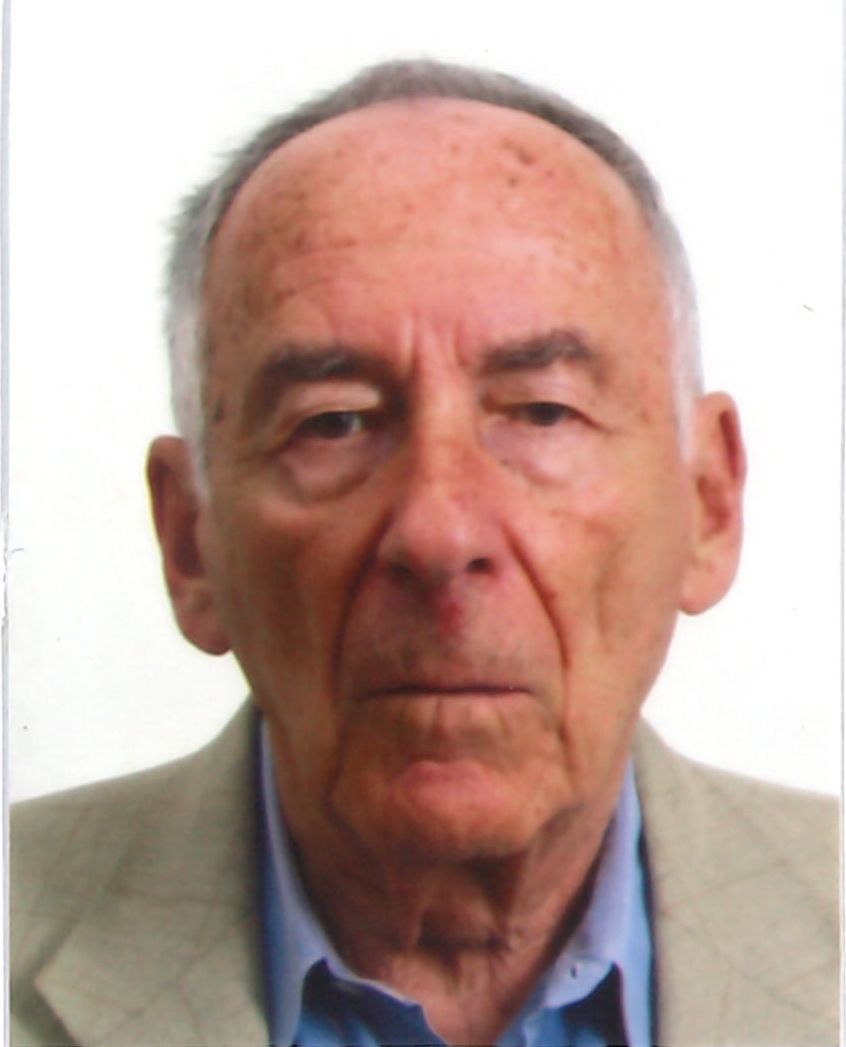 Professor Emeritus, Technical University of Torino
Professor Emeritus, Technical University of Torino
Academic Records:
1971-1979 Associate Professor,
1980-2007 Full Professor of Geotechnical Engineering, Technical University of Torino.
Since 2008 Emeritus Professor of C.E. Technical University of Torino.
Founder and Chairman of the Engineering Consultant Company, Studio Geotecnico Italiano.
Most relevant appointments:
1985-2011 Geotechnical Consultant for the Suspension Bridge over Messina Straits
1994-1997 President of the International Society for Soil Mechanics and Geotechnical Engineering.
1990-2001 Chairman of the International .Committee for Safeguard of the Leaning Tower of Pisa.
1996- to present Member of the International Advisory Group of the European Bank for Reconstruction and Development for the design and construction of the New Safe Confinement of the reactor in Chernobyl Nuclear Power Plant.
1992-to present Chairman of the International Board Expert for Development of the Second World Largest Copper Mine Tailings Depository Zelazny Most in Poland
2001-2011 Geotechnical Consultant for the Engineering Company Technital designer of the MOSE Project in Venice for Safeguarding Venice from high tides
2005- to present Chairman of the Technical Committee for Safeguard of Rome Monuments During Construction of the New Subway Line C Underpassing Historical Centre 2005-to present Foreign Associate US National Academy of Engineering
Awards and Honors (selected):
K. Terzaghi and R.B. Peck Awards, from the ASCE E.
De Beer Awards, from the Belgian Geotechnical Society
Honorary International Member of the Japanese Geotechnical Society
Doctor Honoris Causa: University of Bucharest, University of Ghent, SGGW, Life University(Warsaw)
Recipient of the Italian Prize “Savior of the Art”
Honorable International Member of the Japanese Geotechnical Society; 1998-present
Honorary Professor Academia Sinica of Guangzhou, China
Commendatore of the Italian Republic bestowed by the President of Italy
Foreign Member of the Polish Academy of Science
Member of the Lagrangian Academy of Science, Torino
ROLE OF IN-HOLE GEOPHYSICAL TESTS IN GEOTECHNICAL SITE CHARACTERIZATION
Jamiolkowski(1), G. Vaciago(2)
1- Emeritus Professor of Geotechnical Engineering, Technical University of Torino, Italy
2- Technical Director, Studio Geotecnico Italiano, Milan, Italy
As shown by Stokoe et al. (2004, 2011), the benefits of using seismic measurements in geotechnical engineering are gaining increasing recognition. In this paper, the authors focus on the role played by in-hole geophysical tests in determining soil properties relevant in geotechnical design, with reference to three typical applications.
Firstly, the paper describes a semi-empirical method to evaluate the quality of undisturbed samples based on comparing the seismic body S-waves velocity Vs propagated in situ to that measured on specimens tested in the laboratory. Contrary to other methods which are only applicable in clay, this method may be used in any geomaterial. Examples are presented of application to sand-like soils including copper tailings, over consolidated fine-grained soils and frozen gravelly sands.
Secondly, the paper deals with the use of seismic body P-waves velocity Vp to distinguish with great precision zones of full and partial saturation in situ, which plays a vital role in evaluating the resistance of the deposit to static and cyclic liquefaction. Repeated cross-hole tests were used as part of ongoing safety evaluation to monitor the depth of the phreatic surface and to distinguish between fully and partially saturated tailings at one of the world’s largest upstream copper tailings disposal facilities, located at Zelazny Most in South-West Poland owned by KGHM, which currently stores over 600x106 m3 of tailings.
Finally, the paper illustrates the approach proposed by Foti et al. (2002) to determine porosity from Vs and Vp. This approach has been validated with positive results for a broad spectrum of fully saturated geomaterials. The validation is extended to sand-like tailing by comparing the results obtained from high quality cross-holes tests and direct measurement in laboratory tests carried out by the Polish geotechnical company Geoteko on high quality undisturbed samples retrieved by employing the Gel-Push sampling technology recently developed in Japan.

Lead Campus Manager, Dwight D. Eisenhower, Transportation Fellowship Program, FHWA
Professor, Department of Civil Engineering, The University of Texas at Arlington, Arlington
• Chair, Unsaturated Soils Committee, Geo‐Institute of ASCE.
• Professor, Department of Civil Engineering, UTA, Texas, 2014–current.
• Associate Professor, Department of Civil Engineering, UTA, Texas, 2005–2014.
• Assistant Professor, Department of Civil Engineering, UTA, Texas, 2000–2005.
• Lockheed Martin Aeronautics Excellence in Teaching Award, College of Engineering, University of Texas at Arlington, 2014.
• Research Excellence Award, Office of the Provost, University of Texas at Arlington, 2006, 2007, 2008, and 2009.
• Outstanding Civil Engineering Instructor Award, Department of Civil Engineering, University of Texas at Arlington, 2005.
• Outstanding Early Career Faculty Award, College of Engineering, University of Texas at Arlington, 2003.
Lecture Title: Suction Stress Characteristic Curves of Cohesive-frictional Soils from Multiple Suction-controlled Testing Methods

Professor, Louisiana State University, USA
Dr. Louay Mohammad is a national and international expert in the area of pavement materials and sustainable asphalt construction. He is the holder of the Irma Louise Rush Stewart Distinguished Professor and the Transportation Faculty Group Coordinator at Louisiana State University (LSU). He also serves as the director of the Engineering Materials Characterization and Research Facility at the Louisiana Transportation Research Center (LTRC). Dr. Mohammad teaches and conducts research in the area of Highway Construction Materials, Pavement Engineering, Accelerated Pavement Testing, Advanced Materials Characterization and Modeling, and Infrastructure Sustainability. Dr. Mohammad has served as the PI or Co-PI on more than 58 research projects (NCHRP Project 9-40 and 9-40A, NCHRP Project 9-48, NCHRP 9-49A, NCHRP 10-84, NCHRP Project 20-07/Task 361, etc.) totaling over U.S. $12.4 million. He has authored/coauthored more than 270 publications in pavement engineering including over 150 refereed papers and delivered over 170 keynote and invited presentations at national and international conferences. He has developed many standard test methods (AASHTO TP 114, AASHTO TP 115, and Louisiana DOTD TR 330) and mechanistic models that have impacted pavement materials characterization and performance, and contributed to changes of asphalt specifications. He is the Chair of ASTM subcommittee D 4.25 on Bituminous Mixture Analysis, Past Chair of the TRB Committees AFK40 on Characteristics of Bituminous-Aggregate Combinations to Meet Surface Requirements and member of TRB committee AFK50 on Characteristics of Bituminous Paving Mixtures to Meet Structural Requirement, and TRB committee AFK30 on Characteristics of Non-Asphalt Components of Asphalt Paving Mixtures. Dr. Mohammad currently serves as the Flexible Pavement Section Editor of ASCE Journal of Materials in Civil Engineering, Associate Editor of the Journal of Engineering Research and International Journal of Pavement Research and Technology. Dr. Mohammad has been recognized with the 2013 Best Paper Award of the 8th International Conference on Road and Airfield Pavement Technology, 2010 Distinguished Research Paper of the Journal of Engineering Research, the 2009, 2012, and 2015 Asphalt Rubber Ambassador Award, and the 2002 Association of Asphalt Paving Technologists Board of Directors Award of Recognition.
Lecture Title: Durable Flexible Pavements: Emerging technologies and Trends
 George Leventis, PE, F.ASCE
George Leventis, PE, F.ASCE
Managing Principal/Executive Vice President, Langan
Managing Director, Langan International
George Leventis serves on the Board and Executive Committee of Langan, a 1,000+ consulting engineering firm and is Managing Principal of the firm’s New York office. Also, as Managing Director of Langan International, he spearheaded opening offices in the Middle East and London. Between 1998 and 2001, George served as Director General of the Organizing Committee for the Athens 2004 Olympic Games.
George holds a BS in Civil Engineering from National Technical University of Athens and an MS in Geotechnical Engineering from UIUC. He has 30+ years of land development engineering experience on waterfront, residential, commercial, and supertall buildings; and has been Technical Advisor on large P3 concessions including: Rion-Antirion Link, Greece; Chacao Channel Bridge, Chile; Kastelli Airport, Crete and Olympia Odos Motorway, Greece.
Currently, George is Full Adjunct Professor at Columbia University teaching a graduate course on deep foundations for supertall buildings. He is also Regional Director of ACEC, ASCE Fellow, member of The Moles, member of Board of Directors of New York Building Congress, and member of Advisory Board of Columbia University CE department and of Stevens Institute of Technology School of Business.
Mr. Leventis has received numerous ACEC State and National project awards, the 2005 ASCE Outstanding Civil Engineering Achievement OPAL and 2007 DFI Outstanding Project Award for Rion-Antirion Bridge, and has been named a 2017 ENR Newsmaker for his Greek Motorway work.
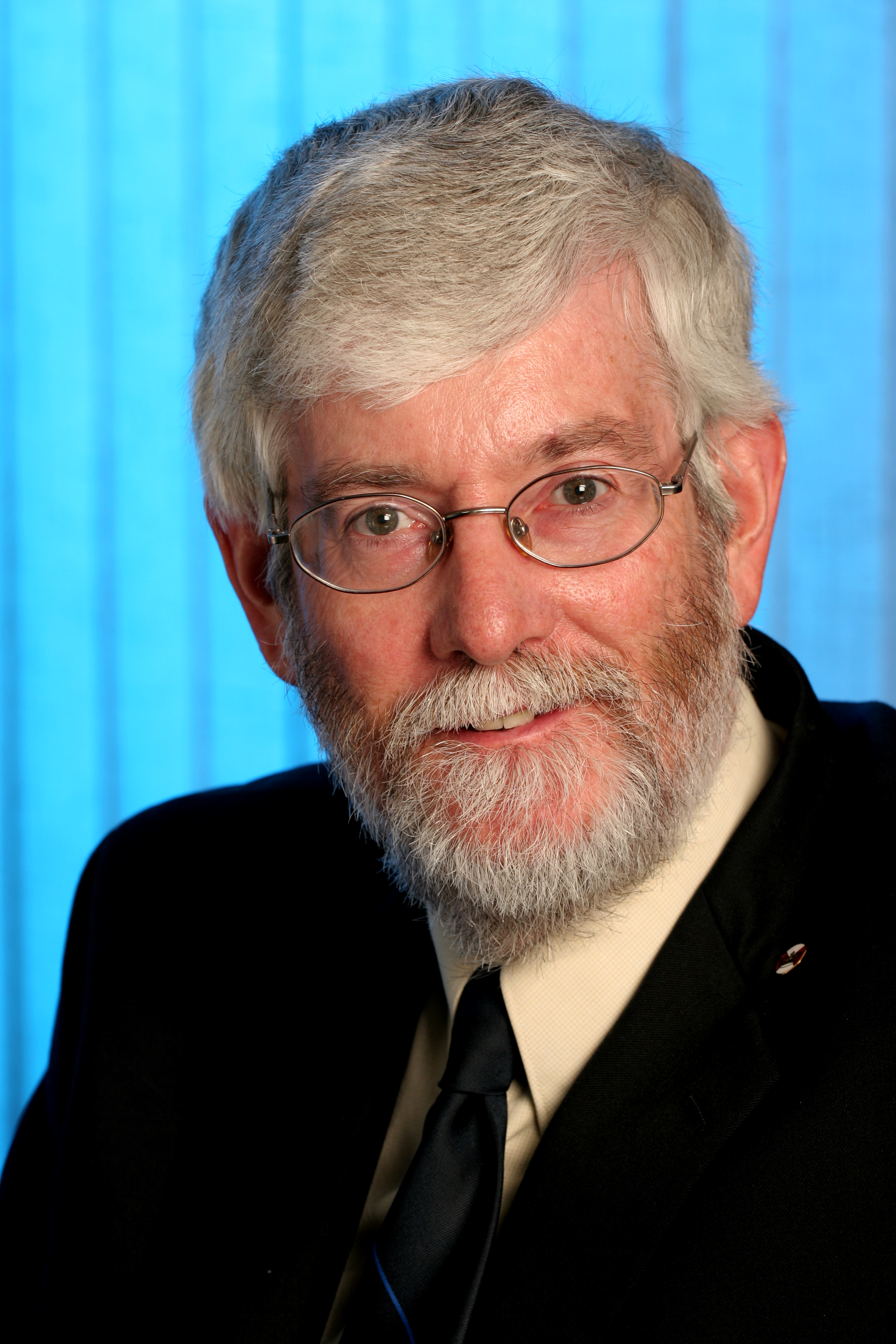
Canada Research Chair in Geotechnical and Geoenvironmental Engineering at Queen’s University in Kingston Canada.
Rowe has published extensively, including two books and has 40 years research and consulting experience in embankments of soft soil, soft ground tunnelling, geosynthetics, waste management, and geoenvironmental engineering. He is a past president of the International Geosynthetics Society, a foreign member of the US National Academy of Engineering, and a Fellow of The Royal Society of London.
Rowe worked as a geotechnical engineer with the Australian Government Department of Construction prior to emigrating to Canada in 1978, where he spent 22 years as a professor, including 8 years as Chair of the Department of Civil and Environmental Engineering at The University of Western Ontario, London, Canada.
From 2000 to 2010 he served as Vice-Principal (Research) at Queen's University in Kingston, Ontario where he was responsible for the administration of all research (in Business, Education, Humanities, Law, Social Sciences, Physical and Biological Sciences, Engineering and Applied Sciences, Health Sciences and Medicine). He is presently (2013) a Professor and the Canada Research Chair in Geotechnical and Geoenvironmental Engineering in the Department of Civil Engineering at Queen's.
His research has covered contaminant migration through soil and rock, landfill design, containment of contaminated sites, geosynthetics tailings storage facilities and dams, reinforced embankments and walls, tunnels in soft ground and the failure of slopes and excavations. In particular he has researched the effectiveness of plastic (geomembrane) liners and geosynthetic clay liners (a composite material incorporating clay) that limit contamination from mining operations and waste disposal facilities.
He is a past President of the International Geosynthetics Society, the Canadian Geotechnical Society and the Engineering Institute of Canada.
Geosynthetics for construction on soft foundation soils; Mercer lecture 2019-2020
This lecture examines the progress made in the last few decades with respect to the use of geosynthetics for aiding in the construction on soft soils. Particular emphasis is placed on advances since the author’s 2002 Giroud lecture. Consideration is given to basal reinforcement, prefabricated vertical drains, and embankments with reinforcement and other supports such as piles. Consideration is also given to different soft soils ranging from peat to rate sensitive soft clay and silt.
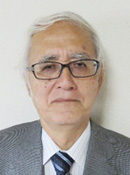
Professor Emeritus of University of Tokyo and Tokyo University of Science, Japan
He received the degree of PhD in Geotechnical Engineering, University of Tokyo 1973 and is Professor Emeritus of University of Tokyo and Tokyo University of Science. He was Vice President, ISSMGE (2001-2005); President, Japanese Geotechnical Society (2007-2008); Vice President, Japanese Society for Civil Engineers (2005-2006); and Vice President and President, International Geosynthetic Society (2002-2006 & 2006-2010). He is specialized in the deformation and strength characteristics of geomaterials, ground improvement and geosynthetic-reinforced soil structures. He received 1994 IGS Award; 1996-1997 Mercer Lectureship, ISSMGE/IGS; 1996, 2000 & 2003 Hogentoglar Award, ASTM; 1997 Best Paper Award, the Ground Improvement Journal, ISSMGE: 2007, 2008, 2010 & 2011 Best Paper Award, Geosynthetics International Journal; 2008 Best Paper Award, Geotextiles and Geomembranes Journal; 2011 Bishop Lectureship, ISSMGE and many others. He wrote a number of technical papers in international journals and did a number of invited lectures at international conferences and symposia of Geotechnical Engineering and Geosynthetic Engineering.
Geosynthetic-reinforced soil structures for railways and roads – developments from walls towards bridges -
The developments and construction of various types of geosynthetic-reinforced soil (GRS) structures for railways and roads, for the last thirty five years in Japan is described. In the 1980’s, GRS retaining wall (RW) with full-height rigid (FHR) facing was developed. The FHR facing is constructed firmly connected to reinforcement layers after the full-height wrapped-around reinforced soil wall and subsoil has deformed sufficiently. In the early 1990’s, to increase the stability and to decrease the deformation, in particular to restrain the developments of bump immediately behind the abutments, GRS Bridge Abutment supporting one end of a simple girder at the top of the FHR facing was developed. In the early 2000’s, GRS Integral Bridge was developed, which structurally integrates both ends of a continuous girder to the top of the FHR facings of a pair of GRS RWs without using girder bearings. By the summer of 2019, these GRS structures have been constructed at more than 1,200 sites and the total wall length has become more than 180 km, without any problematic case during and after construction. The use of FHR facing, the staged construction of FHR facing and the structural integration of the backfill and FHR facing (and also the bridge girder for GRS Integral Bridge) are the three major breakthrough technologies for the developments of these GRS structure.
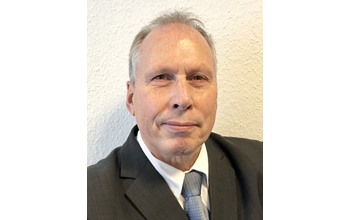
Mr. Kent P. von Maubeuge;
Marketing Director and Product Manager, NAUE GmbH & Co. KG
Kent von Maubeuge studied civil engineering and also obtained his Master of Science degree. For more than 25 years, he has been an active member of various associations, such as DIN, CEN and ISO. He is also a member of ASTM International and is especially involved as chairman (D35.04) in standards for GCLs. He also serves as Chairman for CEN TC189/WG6 Barriers and the Technical Committee IGS Barrier Systems. He has chaired both ASTM past workshops on GCLs as well as the recent ASTM symposium on multi-component GCLs in the States (in 2012). He is also geosynthetic lecturer on the University of Applied Sciences Bielefeld and the University of Applied Sciences Ostwestfalen-Lippe.
Kent has published and presented many international papers on geosynthetics and has contributed to numerous conferences as chairman throughout the world. For a German geosynthetics manufacturer (NAUE) he is senior Director of Product Marketing/Management and is also involved with international concerns. Further involvement in the geosynthetic industry includes: Task group leader ISO 221 WG6/PG9 Designing with Barriers, BoA Geosynthetic Institute, IGS Council member and member of the Technical Advisory Committee Geosynthetics (IFAI).
Regulated groundwater protection in roads with geosynthetic barriers
Groundwater protection is gaining more and more of importance. The German RiStWag regula-tion focuses on barriers under roads, whereas the MTSE regulation describes details on barrier construction systems with environmentally concerning materials (ECM), such as in dams or noise barriers. Worldwide more and more road noise and view-blocking barriers are being built along roads, motorways and railway lines, with a core that is made from ECM. This waste material can be in the form of slag, ash from municipal waste incineration plants or contaminated soil from the rehabilitation of contaminated sites, residue from con-struction waste recycling or industrial processing residue. These waste products have to meet certain envi-ronmental-chemical requirements and must be provided with a surface sealing for groundwater protection. This sealing system can be designed as a mineral sealing (compacted clay liner, CCL) or it can be made of geosynthetic material (geosynthetic clay liners, GCLs; geomembranes). Many noise barriers have relatively steep slopes because there is limited space and the higher the barrier and the steeper the slope the greater the noise protection. The sealing and drainage systems therefore frequently require reinforcement in the form of geogrids to ensure slope stability.
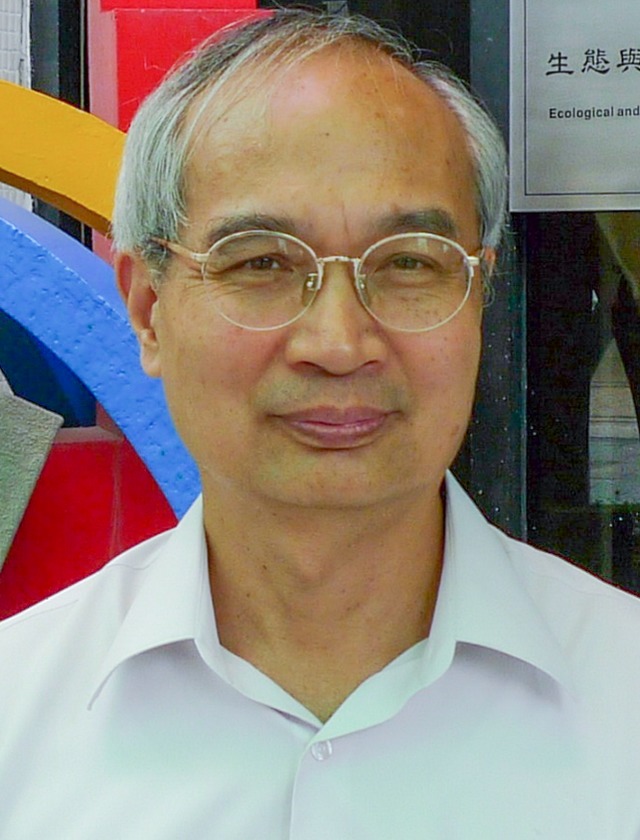
President of Chinese Taipei Geotechnical Society
Chang-Yu Ou is Professor of Construction Engineering at the National Taiwan University of Science and Technology in Taipei. Professor Ou's focus of research is on studies of soil behaviour and excavation problems and he has published many journal and conference papers on these subjects. In parallel to his academic career, he has worked closely with industrial builders, taking part in many large-scale excavation projects, gaining valuable practical experience in analysis and design.
(1) Chair Professor of Department of Construction Engineering, National Taiwan University of Science and Technology
(2) Coordinator of Civil Engineering Program of the National Science Council
(3) Editor-in-Chief, Journal of GeoEngineering
(4) Author of the "Deep Excavation: Theory and Practice" Book
Lecture Title: Control of movement induced by deep excavation
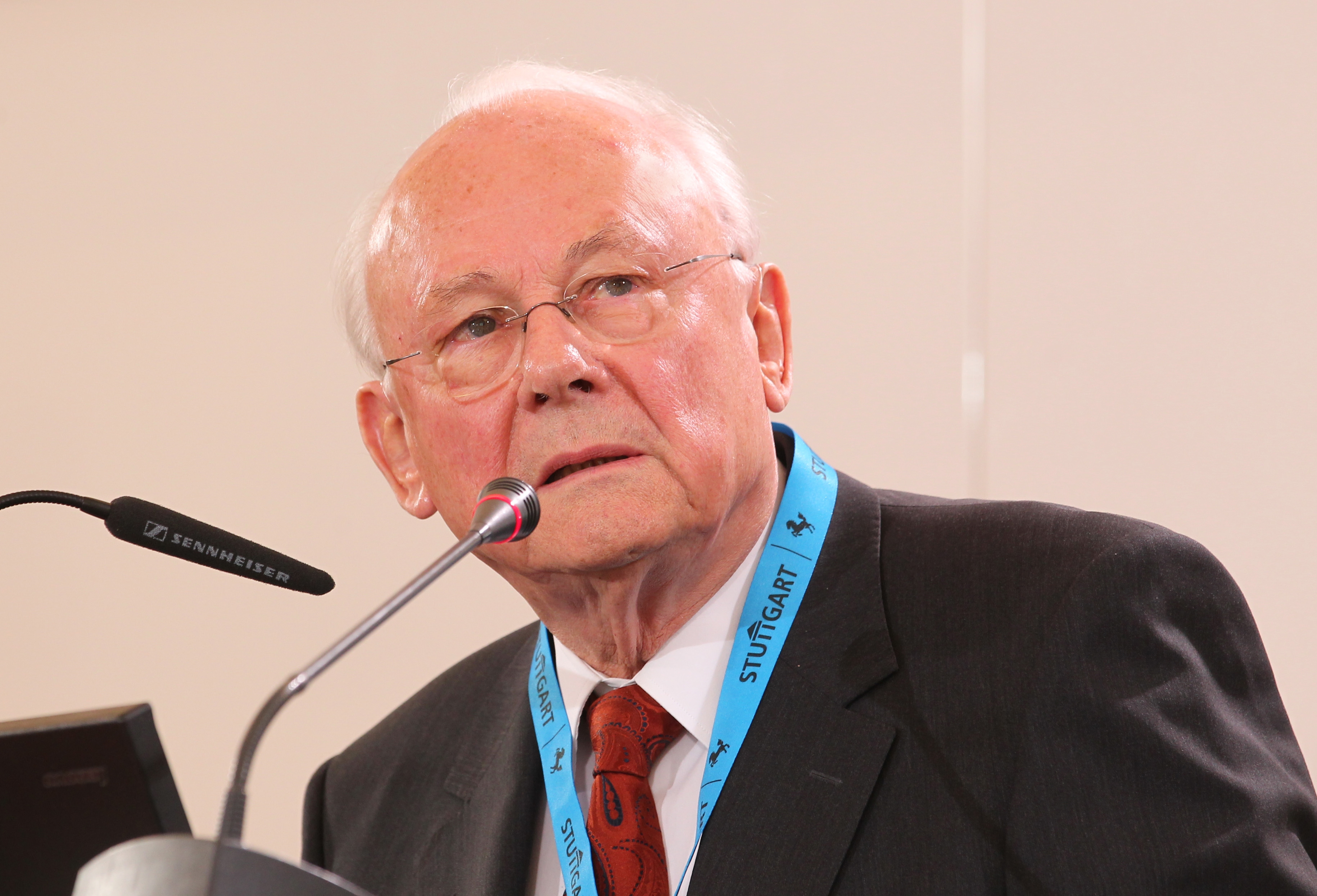
Global Expert of Rock Mechanics and Tunnelling Engineering
Walter Wittke is a visionary and a devoted engineer. The Professor Emeritus and founder of the engineering company WBI lives for his family and for his profession. Educated as structural engineer, he dedicated his professional life to geotechnical and rock mechanical engineering. As one of the pioneers in rock mechanics, back in the 1970ies, he started to develop models for the realistic description of the behavior of jointed rock masses under consideration of discontinuity characteristics, and implemented these in numerical codes. These models and codes form the basis for the realistic consideration of the interaction of ground and structure, which is of utmost importance in geotechnical works. Walter Wittke always put particular emphasis on the combination of research and practice. He successfully applied the technical models in numerous projects, refined and expanded them. The result of decades of research and practice in rock mechanics is summarized in the book "Rock Mechanics Based on an Anisotropic Jointed Rock Model (AJRM)", which was published in 2004. After long years of serving the geotechnical community and the university, Walter Wittke is now focusing on his work as an engineer in his company WBI, together with his children and his employees, and thus continues to indulge his passion for geotechnical engineering.
Lecture Title: Tunnel and Dam Design accounting for the interaction of ground and structure
The importance of accounting for the interaction of ground and structure will be outlined by means of two case histories: The 139 m high roller compacted concrete dam El Zapotillo is founded on highly deformable Tuff. Thus, displacements of the dam foundation at the valley bottom and the slopes due to the self-weight of the dam and due to impounding of the reservoir have a considerable impact on the deformation and the stresses in the concrete dam. By means of extensive studies with 3D-FE-Analyses, an optimum shape has been developed for the roller compacted concrete dam, which is presently under construction in the state of
Jalisco, Mexico. An approx. 18 m wide and 14 m high tunnel in soft ground is excavated in the center of the city of Stuttgart, Germany, underneath multistory buildings. Excavation is carried out according to the conventional tunneling method. The support consists of 50 cm thick fiber reinforced shotcrete and of an advancing steel pipe umbrella (forepoling). The vertical temporary face is supported by reinforced shotcrete and face anchors. Extensive underground and above ground monitoring is carried out. Subsidence resulting from tunnel driving is comparatively small and in good agreement with the results of the stability analyses, which were carried out on the basis of 3D-FE-calculations.
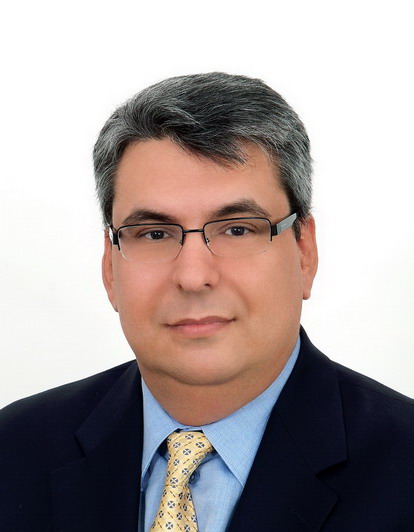
Vice President, International Accreditation Service (IAS)
Dr. George Anastasopoulos is the Vice President of International Accreditation Service (IAS). He is a Mechanical Engineer with an MSc and a PhD in Applied Mechanics from Northwestern University. He is member of ISO TC176 and CASCO committees who
developed the new ISO 9001 and ISO/IEC 17025. He is awarded with the EOQ Presidential Georges Borel Award for international achievements in quality. He presented lectures related to Accreditation, Conformity Assessment, Management Systems, BPR, Telecoms-FTTH-IT and Process Auditing. He participated in consulting and research projects in USA, European Union and many other countries worldwide.
Presentation Title: Improving Performance of Testing Laboratories – A Statistical Review and Evaluation
This paper outlines the most common quality challenges testing laboratories are facing during their accreditation process. Accreditation is the independent evaluation of conformity assessment bodies (i.e. Testing laboratories) against recognized standards to carry out specific activities to ensure their impartiality and competence. Through the application of national and international standards, government, procurers and consumers can have confidence in the quality of test results, inspection reports and certifications provided.
This study has been performed based on data collected by more than 300 testing laboratories, from 41 countries worldwide, accredited against the requirements of the international standard ISO/IEC 17025-2005 “General requirements for the competence of testing and calibration laboratories (1).”
The Non-Conformities were issued during the accreditation process of various testing laboratories specializing in different testing categories (Civil, Geotechnical, Mechanical, Electrical, Chemical, Microbiological, etc.). Findings vary from commonly reported quality management system issues to the most demanding technical challenges faced by testing laboratories.
The identified Non-Conformities were categorized and statistically processed. The trends are identified and analyzed per quality management system or technical category. Under the accreditation process, laboratories are required to respond to any significant findings with a submittal of a corrective action plan containing an analysis of the root cause, details of actions taken to resolve the issue and strategies to prevent reoccurrence. Various responses were analyzed and some suggestions and good practices were gleaned from these submittals. Opportunities for improvement are presented for each corresponding category of findings.
(1). ISO/IEC 17025:2005 specifies the general requirements for the competence to carry out tests and/or calibrations, including sampling. It covers testing and calibration performed using standard methods, non-standard methods, and laboratory-developed methods. It is applicable to all organizations performing tests and/or calibrations. These include, for example, first-, second- and third-party laboratories, and laboratories where testing and/or calibration forms part of inspection and product certification. The standard is applicable to all laboratories regardless of the number of personnel or the extent of the scope of testing and/or calibration activities.
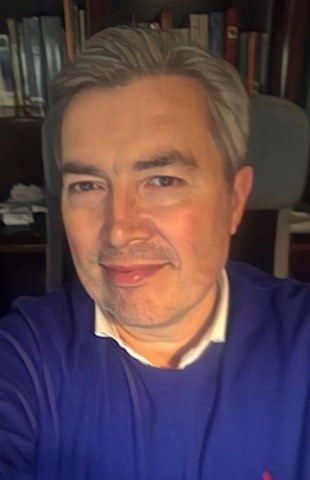 Professor, University of Napoli Federico, Italy
Professor, University of Napoli Federico, Italy
Born in Pompei in 1967, graduated in Civil Engineering in Naples in 1992 with the highest honors cum laude. In 1992, resulted first in the competition for admission with a scholarship to the PhD course in Geotechnical Engineering – Univ. Roma-La Sapienza and Napoli Federico II. In 1996 he obtained the title of Doctor of Philosophy, and in 1997 he was awarded with a scholarship for a post-doctoral research topic jointly with the University of Ghent (Belgium) on the experimental behavior of piled foundations In 1998-1999 worked abroad with the Building Research Establishment (UK) participating in the monitoring of the underground extension of the Jubilee Line in London, while the results of the experimental work of monitoring the foundations of the cable-stayed bridge over the river Garigliano - Ph.D. thesis - were selected by the Technical Committee TC 18 of the International Association of Soil Mechanics and Geotechnical Engineering (ISSMGE) for a Workshop based on the prediction of the observed behavior by the major research groups on pilings (Ghent,1998) .In 2000 he won the competition to the position of research assistant in the University of Napoli Federico II. From 2000 to 2008 he held several courses in the field of Geotechnical Engineering at the University of Naples Federico II and at the University of Sannio, Benevento. In 2005 he was appointed as associate professor in Geotechnical Engineering after a national competition in 2004. From 2009 he teaches in Polytechnic School of the Federico II the course on Foundation Engineering. From 2017 he is also involved in the Master course on Retrofit of historical and monumental buildings and in the Master course on Geotechnical Engineering for design of Federico II. In 2003 he was appointed to act as a panelist for BAP IV International congress on the theme of "piled rafts." In 2004 was designated from organizing committee of the Vth Int. Conf. On Case histories in Geotechnical Engineering (NY (USA)) to prepare the General report of the session Shallow and Deep Foundations.In 2005, he was designated as co-author by ISSMGE for the General Report on the State of the Art of Pile foundations on the occasion of the World Conference of ISSMGE in Osaka. In 2006 he was appointed as speaker at the National Conference of Geotechnical Engineering in Bari on the topic of "Pile foundations: experimental evidence." He was co-author designated by the British Geotechnical Association for a keynote lecture at the Second International Conference on Foundations ICOF 2008 on the theme of the piles under horizontal actions. He was designated for deliver the Keynote lecture (2010). “Excavations in the urban environment: examples from the construction of Napoli Underground.” in the Proc. Int. Geotech. Conf. on Geotechnical Challenges in Megacities, Moscow, Russia.He was designated in the conference 7th International Symposium on Geotechnical Aspects of Underground Construction-Rome May 2011 as panelist on the theme of the excavations of the Naples Metro Line 6. He was asked by the Scientific Committee to act as Discussion Leader organizer of the session "Tunnelling" at the XV European Conference of the European Association ESSMGE Athens 2011.In 2017 he was chairman of the session “Structural and Earthquake Engineering” of the 3rd International Conference on the Protection of Historical Building – Lisbona (ProHitech_2017)He is author of over 100 scientific publications and a monograph in English, published by Taylor & Francis on the topics of shallow and deep foundations. The largest part of his scientific production deal with soil-structure interaction for shallow and deep foundations, tunnels and deep excavations and with the seismic behavior of tunnels.He has been recently elected as a member of the presidential council board of the Italian Geotechnical Association (member of ISSMGE).He acts as a reviewer for a number of International Journal as ASCE Journal of Geotechnical and Geoenvironmental Engineering; Soils & Foundations; Computers & Geotechnics; Acta Geotechnica; Geotechnique; Canadian Geotechnical Journal.
Excavations in Napoli for the construction of new underground lines: Effects on the surrounding civil structures including historical buildings
Several case histories from the huge development plan concerning the construction of both line 1 and line 6 of the Napoli underground network are presented. The cases are deep shafts where the groundwater control and management have played a relevant role both on design issues (i.e. technologies and budget) and on the observed effects on the surrounding buildings. Most of the lecture is focussed on a careful work of interpretation of a large amount of monitoring data and on the relationships between the observed effects on civil structures and the various construction stages. The presence of valuable and historical buildings among the structures affected by the displacement induced during the excavation stages makes the problem of course more complex and significant. Finally the use of back-analysis with either simple empirical procedures or advanced FEM modelling is presented. The main aim of this last section of the lection is of course that of validating procedures and methods and, above all, of calibrating parameters usually introduce for engineering predictions at the design stage.
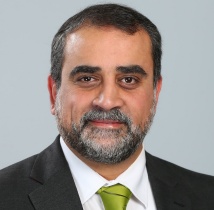
Associate Professor and Graduate Coordinator, Dalhousie University, Canada
“Dr. Hany El Naggar is an Associate Professor of Geotechnical Engineering at Dalhousie University with more than 24 years ofexperience in civil construction, geotechnical and structural engineering and research in Canada and overseas. He has participated in several geotechnical and structural investigations and is experienced in analysis and design of foundations and soil- structure interaction of buried infrastructure. Dr. El Naggar and his research team has investigated the soil-structure interaction (SSI) effects around buried infrastructure; explored innovative use of tire derived aggregate (TDA) as a buffer zone to create stress arching and reduce demand on rigid culverts, proposed an earth pressure reduction system using geogrid reinforced platform bridging system to reduce stresses on buried utilities, and developed innovative “cellular” precast concrete pipe system.
Also, He has developed asimplified technique to account for the group Effect in pile dynamics; and closed form solutions for the moments and thrusts in jointed and un-jointed composite tunnel lining systems, designed several foundation systems ranging from machine foundations subjected to dynamic loads to raft foundations for underground structure, as well as several tunnels and underground structures in Canada, Europe, Middle East, and the United States. The findings from Dr. El Naggar’s research have been reported in more than 100 technical publications covering both experimental and numerical work in the fields of soil-structure interaction, buried infrastructure and concrete pipes. He has given several workshops and short courses on various geotechnical engineering topics including Foundation Design, Geotechnical Earthquake Engineering, and Buried Infrastructure Design and they are very well received by practitioners. He is the recipient of the 2016-2017 Outstanding Teaching Award from the Faculty of Engineering, Dalhousie University. In addition, he received the 2005-2006 Outstanding Teaching Award from the Department of Civil and Environmental Engineering at Western. Dr. El Naggar won the 2006 L. G. Soderman Award, the 2005 R.M. Quigley Award, and the 2004 Milos Novak Memorial Award.
Dr. El Naggar is the current chair of the Buried Structures Committee of the Canadian Society of Civil Engineers (CSCE); also, he is the ex-chair the of the New Brunswick chapter of the Canadian Geotechnical Society; he is also member of the technical committee on buried structures of the Canadian Highway Bridge Design Code (CHBDC). He is a member of several professional associations including the Association of Professional Engineers of Nova Scotia; the Association of Professional Engineers of Ontario (PEO); the Canadian Society of Civil Engineering (CSCE), the Canadian Geotechnical Society (CGS); the International Society for Soil Mechanics and Geotechnical Engineering (ISSMGE); and the Engineers Syndicate, Egypt.
Lecture Title: Seismic Design of Soil-Metal Arch Bridges
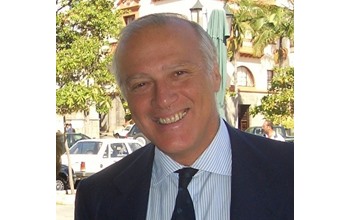
Chairman & Executive President, CARPI TECH, Switzerland
A.Scuero graduated in Hydraulic Civil Engineering at Turin Polytechnic in Italy. After working for major civil engineering construction companies in Italy and Africa, in 1986 he joined CARPI, a private Dutch group that works in the field of waterproofing with geosynthetics. He has been involved in research on geomembrane technologies, for which he invented and holds several patents, in design and application of waterproofing geomembrane systems to all types of hydraulic structures, including 120 large dams. He was the coordinator of the ICOLD European Working Group who prepared ICOLD Bulletin 135 on Geomembrane Sealing Systems for Dams.
Lecture Title: A geomembrane liner to stop water seepage in an 8 km long embankment: the Bill Young reservoir case history
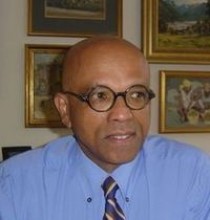
William Scott Professor and Distinguished James McGill Professor in the Department of Civil Engineering and Applied Mechanics, McGill University, Montréal, Canada
A.P.S. Selvadurai is currently William Scott Professor and Distinguished James McGill Professor in the Department of Civil Engineering and Applied Mechanics, McGill University, Montréal, Canada. He obtained his PhD degree in Theoretical Mechanics from the University of Nottingham, under the tutelage of the world-renowned continuum mechanicist, the late A.J.M. Spencer. In 1986 the University of Nottingham awarded him its first ever research DSc in Theoretical Mechanics. He was Professor and Chair of the Department of Civil Engineering at Carleton University, Ottawa, 1982 to 1991, and from 1993 to 1997, the Chair the Department of Civil Engineering and Applied Mechanics at McGill University.
Dr. Selvadurai was awarded the Humboldt Senior Scientist Award and in 2000 (re-invitation Award, 2019) and the first civil engineer to be awarded the Killam Research Fellowship (Canada Council for the Arts). In 2003 he received the prestigious Max Planck Research Prize in the Engineering Sciences. In 2007, he received The Killam Prize for Engineering, awarded by the Canada Council for the Arts and the CANCAM Gold Medal, awarded by the Central Committee for Canadian Congresses of Applied Mechanics. In 2008, he received the IACMAG Medal for Outstanding Accomplishments in Theoretical, Computational and Experimental Geomechanics and in 2010 he received the ALERT Medal awarded by Alliance of Laboratories in Europe for Research and Technology. In 2012, he was awarded the degree of Docteur Honoris Causa by the Institut Polytechnique de Grenoble, France. In 2013, he was awarded The Eric Reissner Medal of the ICCES and The Maurice A. Biot Medal of the ASCE. In 2017, he received the Chandrakant S. Desai Medal from the International Association for Computer Methods and Advances in Geomechanics.
His research includes the mechanics of elastic media undergoing large deformations, fracture mechanics, micromechanics of inclusions and defects, poroelasticity, coupled thermo-hydro-mechanical processes in deformable media, mechanics of inhomogeneous media, interfaces in geomechanics, fragmentation of brittle geomaterials, transport in porous media and mechanics of geosynthetics subjected to chemical exposure. He is the author or co-author of texts devoted to Elastic Analysis of Soil-Foundation Interaction (Elsevier, 1979), Elasticity and Geomechanics (with R.O. Davis) (Cambridge University Press, 1996), Partial Differential Equations in Mechanics Vols. 1&2 (Springer-Verlag, 2000); Plasticity and Geomechanics (with R.O. Davis) (Cambridge University Press, 2002), Transport in Porous Media (with Y. Ichikawa) (Springer-Verlag, 2012) and Thermo-Poroelasticity and Geomechanics (with A.P. Suvorov) (Cambridge University Press, 2016). He serves on the Editorial Boards of nine leading International Journals devoted to Geomechanics, Applied Mechanics, Computational Mechanics and Engineering Mathematics. He is a Fellow of several Academies and Learned Societies.
Lecture Title: Thermo-Hydro-Mechanical Processes in Complex Rocks: The Role of Multi-Phasic Approaches

Prof. Dr.-Ing. Yasser El-Mossallamy
Prof. Yasser has been a researcher and consultant since 32 years. His work includes among others the application of numerical modeling and analyses in geotechnical projects. He has a wide experience by the design and construction of raft and piled raft foundations of high-rise buildings and bridge foundation. He was also involved in many projects dealing with special measures to increase stability of landslides, soil improvement, rock fall hazards and tunneling.
Prof. El-Mossallamy has shared a lot of mega projects in different countries especially in Germany, China, Turkey, Egypt, Saudi Arabia, Kuwait UAE and Jordanian.
Prof. El-Mossallamy is the leader of the geotechnical design group of the challenge earthwork of the Grand Airport in Istanbul since 2014.
Prof. El-Mossallamy is also a chair professor of geotechnical engineering at Ain Shams University, Cairo, Egypt. Prof. El-Mossallamy has more than 100 publications dealing with different geotechnical topics.
Lecture Title: Limitations and Future Use of Soil Improvement in Soft Soil
Yasser El-Mossallamy, Professor of Geotechnical Engineering, Ain Shams University, Cairo, Egypt,
Gerhard Schulz, Arcadis, Germany, www.arcadis.com
ABSTRACT: The rapid development in the last decades all over the world specially in Egypt leads to the need of complex infrastructure in complicated geotechnical conditions such as the thick layer of soft clay in north Egypt. Therefore, applications of different soil improvement techniques have been applied in many mega projects. The preloading technique with wick-drains was applied intensively to prepare the lands for the investors. In the last years, the wick-drains technique was applied in many areas worldwide. This paper will discuss the possibilities and the limits of the applications of wick-drains considering different case histories where wick-drains have both positive and negative results to show the limitations of this technique as well as to discuss the possible optimization off the applications of such a technique. Other technique “Deep Dynamic Compaction Pillars” was applied successfully in north Egypt. The possibilities as well as the limitations of this technique will be discussed considering the soft soil below groundwater and the thickness of the soil to be improves. The aim of the paper is to open the discussion how the mega projects on soft soil can be further developed considering the serviceability, safety as well as the economic aspects of the project
Keywords: Soft soil, soil improvement, wick-drains, deep dynamic compaction pillars, serviceability, safety and economic